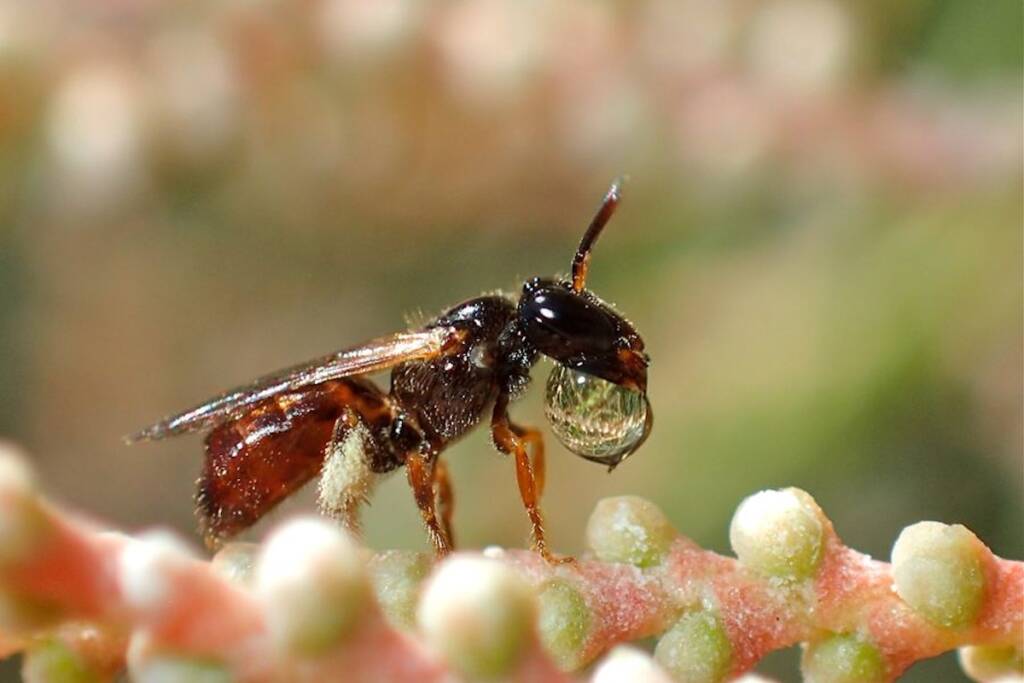Bee BehaviourBubbling Bees Buzz Pollination Operculum lifting behaviour
Images and Contributor Author Gary Taylor ◦
Did you know that certain native bees create bubbles. One such species are the Amegilla chlorocyanea in the act of “bubbling”. As Gary has said:
“Bubbling” is a process where the bee will regurgitate the watery nectar it has sucked up into a small ball, that it holds with it’s mouthparts, to evaporate the water out and condense it.
Gary Taylor, Western Australia

Check out our page on the Amegilla chlorocyanea Bubbling, wonderfully captured by Author Gary Taylor.
The act of when “a bee bubble” is a process by which the bee is thought to be concentrating the nectar that they have collected from flowers, making it more suitable for their needs. Whilst it is not certain that all bees do this, many native bee species are know to and have been seen blowing bubbles. As well as the species Amegilla chlorocyanea, the genus Lasioglossum, subgenus Homalictus and many of the bees from the family Colletidae are known to blow bubbles.

The expulsion of nectar to evaporate the moisture out to condense it can be seen with the following genus Exoneura on a Tamarisk. This bee is about 6 mm long and the one often referred to as a “Reed bee” as she likes to nest in hollow plant stems (such as reeds), although any hollow stem will do. Here we can see the clarity of the nectar bubble at the start (like any spherical lens it inverts the image behind).

In the following picture of the genus Homalictus, again on Tamarisk, this bee is smaller, at about 4 mm long, but just as gorgeous with her stunning metallic green (that changes to stunning gold or incredible copper red depending on the angle of the light on her). This picture shows how she uses her glossa (that’s just scientific for “bee tongue”) to hold and stretch the bubble for faster evaporation. In layman’s term, they blow and suck the nectar in and out, until it’s a bit like Nestlé’s sweetened condensed milk.

In this picture is the genus Lieoproctus, possibly plumosa. This one shows the colour change that comes with the condensing of the nectar, as evident in the bubble.

In the following image, we can see Hylaeus (Gnathoprosopis) euxanthus creating “yellow coloured bubbles”, the colour being derived from pollen in the mixture.

The following Wasp mimic bee (Hyleoides concinna) was seen bubbling at the Australian National Botanic Gardens n Canberra, ACT.

© Emm Gardner
Related/additional information on native bees bubbling:
and blogs:
- To bubble or not to bubble… by Gary Taylor
- Sweat running down my face… by Gary Taylor
- a bit of bubbling… by Gary Taylor
- Bubbling Euryglossinae Dasyhesma… by Gary Taylor
- Under the Woolly Bush… bubbling Amegilla by Gary Taylor
- Bubbling… by Cassidy Taylor
- Ruby… bubbling by Gary Taylor
- A white bubble by Gary Taylor
- the first bubble she threw up by Gary Taylor
Footnote & References
- Images and content contribution by Gary Taylor, Western Australia
- Hylaeus (Gnathoprosopis) euxanthus bubbling, Ballandean QLD © Marc Newman
- Wasp mimic bee (Hyleoides concinna) bubbling, ANBG ACT © Emm Gardner
BeesBees Anatomy Bee Behaviour Blogging Bees… Bees – image index Amegilla Bee Apis mellifera Austroplebeia australis Austrothurgus Braunsapis sp Ceylalictus perditellus Colletidae Euryglossinae Exoneura Homalictus Hyleoides bivulnerata Lasioglossum Lasioglossum (Chilalictus) Lipotriches Megachile Meroglossa Stenotritidae Tetragonula Thyreus Xylocopa
Bee BehaviourBubbling Bees Buzz Pollination Operculum lifting behaviour
